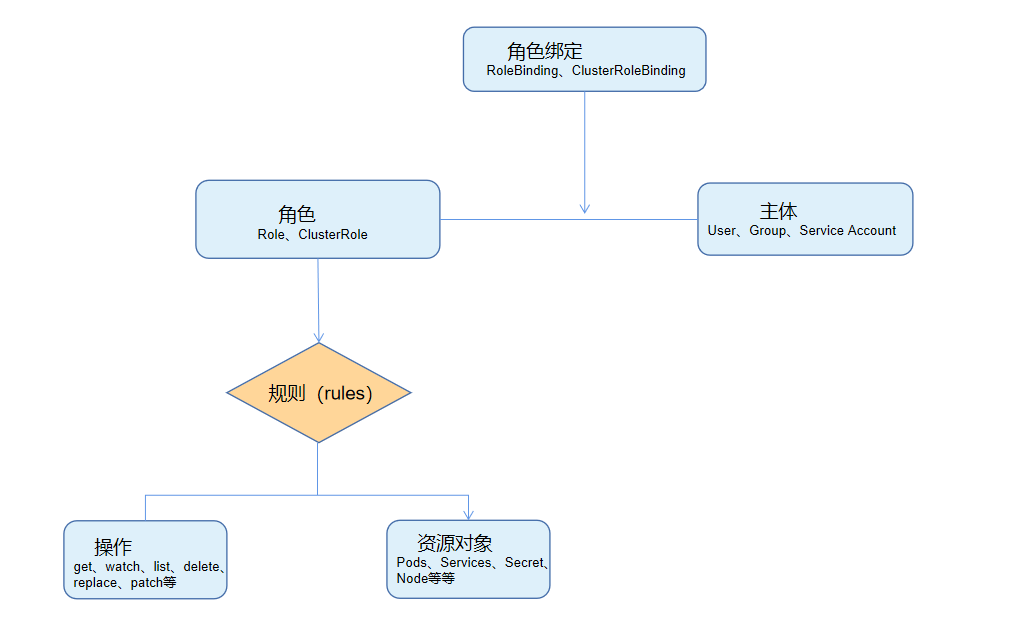k8s--apiserver授权策略----RBAC
k8s API Server 讲解:https://www.cnblogs.com/du-z/p/16140319.html
RBAC授权模式讲解
RBAC(Role-Based Access Control,基于角色访问控制)在k8s的1.5版本引入,在1.6版本升级为Bate版本(公测版),在1.8版本是升级为GA(General Availability)(正式版)。作为kubeadm安装方法的默认选项,足见其重要程度。相对于其他控制方式,新的RBAC具有如下优势:
- 对集群中的资源和非资源权限均有完整的覆盖
- 整个RBAC完全由几个API对象完成,同其他API对象一样,可以用kubectl或API运行进行操作
- 可以在运行时进行调整,无需重启APIserver
要使用RBAC授权模式,需要在API Server启动参数中加上--authorization-mode=RBAC
RBAC授权策略的原理和用法
RBAC的API资源对象说明
RBAC引用了4个新的顶级资源对象:Role、ClusterRole、RoleBinding、ClusterRoleBinding;同其他API资源对象一样,用户可以使用kubectl 或者api调用等方法操作这些资源对象
角色(Role)
一个角色就是一组权限的集合,这里的权限都是许可形式的,不存在拒绝的规则。在一个命名空间中,可以用Role来定义一个角色,如果时集群级别的,就需要使用ClusterRole;Role只能对namespace内的资源进行授权,
示例:
[root@k8s-master yaml]# cat Roletest.yaml
kind: Role
apiVersion: rbac.authorization.k8s.io/v1
metadata:
namespace: default
name: pod-reader
rules:
- apiGroups: [""] #apiGroups可以为空字符串,但不可以为空
resources: ["pods"]
verbs: ["get","watch","list"]
#rules中的参数说明
1. apiGroups:支持的API组列表,[""]空字符串表示核心API群
2. resources:支持的资源对象列表,例如pods、deployments、jobs等
3. verbs:对资源对象的操作方法表,API的REST操作方法,例如:get、watch、list、delete、replace、patch等
集群角色(ClusterRole)
集群角色除了具有和角色一致的命名空间内资源的管理能力外,因其集群级别的范围,还可以用于以下特殊元素的授权
- 集群范围的资源,例如:Node
- 非资源型的路径,例如:"/healthz"
- 包含全部命名空间的资源,例如:pods (用于kubectl get pods --all-namespaces 这样的操作授权)
[root@k8s-master yaml]# cat ClusterRoletest.yaml
apiVersion: rbac.authorization.k8s.io/v1
kind: ClusterRole
metadata:
name: test
rules:
- apiGroups: [""] #apiGroups可以为空字符串,但不可以为空
resources:
- secrets
verbs:
- get
- watch
- list
角色绑定(RoleBinding)和集群角色绑定(ClusterRoleBinding)
Rolebinding或ClusterRoleBinding用来把一个角色绑定到一个目标上,绑定的目标可以是User(用户)、Goup(组)或者Service Account ;使用RoleBinding为某个namespace授权,使用ClusterRoleBinding为集群范围内授权
RoleBinding可以引用Role进行授权;下面例子中的RoleBinding将在default命名空间中把pod-reader角色授予用户du,这一操作让du读取default命名空间中的Pod
kind: RoleBinding
apiVersion: rbac.authorization.k8s.io/v1
metadata:
name: read-pods
namespace: default
subjects:
- kind: User
name: du
apiGroup: rbac.authorization.k8s.io
roleRef:
kind: Role
name: pod-reader
apiGroup: rbac.authorization.k8s.io
RoleBinding也可以引用ClusterRole,对属于同一namespace内的ClusterRole定义的资源主体进行授权;一种常见的做法是集群管理员对集群范围预先定义好一组ClusterRole,然后在多个namespace中重复使用这些ClusterRole
例如,如下虽然secret-reader是一个ClusterRole,但是因为使用了RoleBinding,所以用户du只能读取development命名空间中的secret
kind: RoleBinding
apiVersion: rbac.authorization.k8s.io/v1
metadata:
name: read-secrets
namespace: development
subjects:
- kind: User
name: du
apiGroup: rbac.authorization.k8s.io
roleRef:
kind: CluserRole
name: secret-reader
apiGroup: rbac.authorization.k8s.io
ClusterRoleBinding绑定的角色只能是ClusterRole,用于集群级别或者多所有namespace都有生效的授权;如下示例中,允许manager组的用户读取任意Namespace中的secret
kind: ClusterRoleBinding
apiVersion: rbac.authorization.k8s.io/v1
metadata:
name: read-secrets-global
subjects:
- kind: Group
name: manager
apiGroup: rbac.authorization.k8s.io
roleRef:
kind: CluserRole
name: secret-reader
apiGroup: rbac.authorization.k8s.io




【推荐】国内首个AI IDE,深度理解中文开发场景,立即下载体验Trae
【推荐】编程新体验,更懂你的AI,立即体验豆包MarsCode编程助手
【推荐】抖音旗下AI助手豆包,你的智能百科全书,全免费不限次数
【推荐】轻量又高性能的 SSH 工具 IShell:AI 加持,快人一步
· Manus重磅发布:全球首款通用AI代理技术深度解析与实战指南
· 被坑几百块钱后,我竟然真的恢复了删除的微信聊天记录!
· 没有Manus邀请码?试试免邀请码的MGX或者开源的OpenManus吧
· 园子的第一款AI主题卫衣上架——"HELLO! HOW CAN I ASSIST YOU TODAY
· 【自荐】一款简洁、开源的在线白板工具 Drawnix
2020-04-15 Linux slabtop命令——显示内核片缓存信息